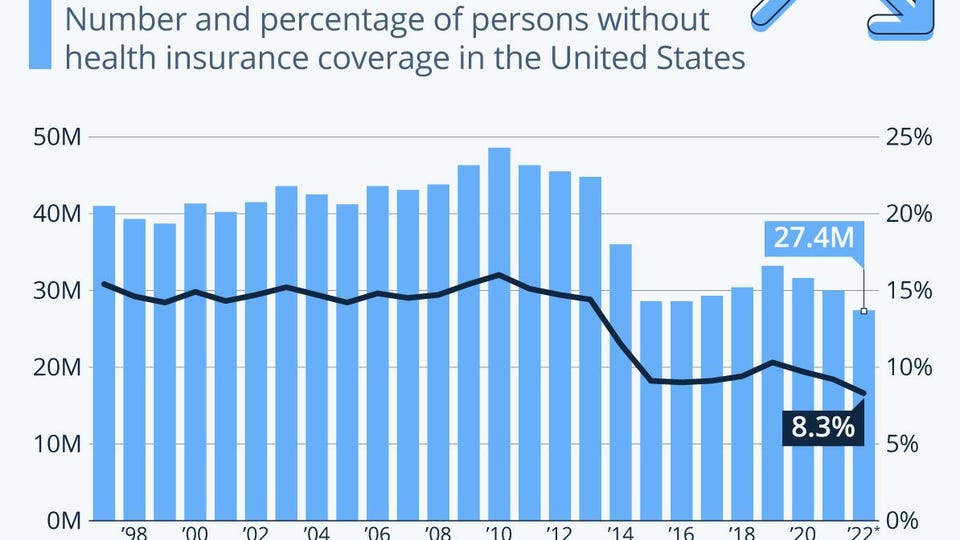Number Of U.S. Uninsured Falls Once More [Infographic]

Open enrollment on the U.S. public health insurance marketplace ended Sunday and as of January 7, almost 16 million people had already signed up to receive coverage in 2023. The number is a new record for the yearly enrollment period and constitutes a 13 percent increase over the 2021/22 sign-up, according to government press release.
Enrollment for coverage under the Affordable Care Act, also dubbed Obamacare, is up for the third year in a row, which is reflected in the rising number of Americans who have health insurance. While many Americans receive health care coverage for themselves and their families through their employers, those working in lower paid professions or freelancing often don’t. Recent expansions to programs like Medicaid and the Affordable Care Act have caused the number of Americans with no health insurance to plummet after it had grown during the Trump administration.

This chart shows the number and percentage of persons without health insurance coverage in the … [+] United States.
Statista
Preliminary data from the National Health Interview Survey published by the Department of Health and Human Services and the Centers for Disease Control and Prevention shows that in the first half of 2022, 27.4 million Americans—or 8.3% of the population—did not have health insurance. This number is down from a high of 33.2 million or 10.3% of Americans in 2019.
Additions to the ACA and Medicaid made by the Biden Administration were part of the American Rescue Plan, a Covid-19 relief bill passed in March 2021, and were extended in the Inflation Reduction Act of 2022. According to the Kaiser Family Foundation, the provisions, notably the introduction of subsidies for applicants earning 400% or more of the federal poverty level, made ACA coverage more attractive for a lot of workers. For example, a 60-year old making just over that poverty level cutoff (around $52,000 per year) formerly could have expected a monthly insurance bill of around $950 or 22% or his or her income through ACA. After the change, the premium would be capped at 8.5% of that person’s income. The same laws extended Medicaid eligibility to new groups, offering health insurance to even more groups that are not covered through their employers.
Challenges to the ACA
With the introduction of the ACA and the expansion of Medicaid in 2014, the number of the U.S. uninsured took a major dip. However, more people went uncovered again in 2017, 2018 and 2019 when the Trump administration cut key parts of the ACA program, including advertising, subsidies for insurance companies and rules about the quality of insurance offered on the exchange. At the same time, the government also decreased Medicaid enrollment by allowing states to skirt some of the provisions they introduced under the program’s expansion as well as discouraging eligible undocumented immigrants from signing up for insurance.
In 2020, Trump’s last year in office, and in 2021, health insurance coverage rose again, however. 8.2 million people chose a plan for the upcoming year from the ACA exchange in 2020—the first increase under Trump, yet only half of the tally of 2023. The sign-up period was the first following the onset of the coronavirus pandemic and the accompanying economic contraction, while also coinciding with a Republican-backed Supreme Court challenge to the program. But even before this extraordinary set of circumstances, health insurance enrollment had been slightly up, rising to cover 90.3 percent of Americans in 2020, then driven by a rise in private, not public insurance.
—
Charted by Statista
